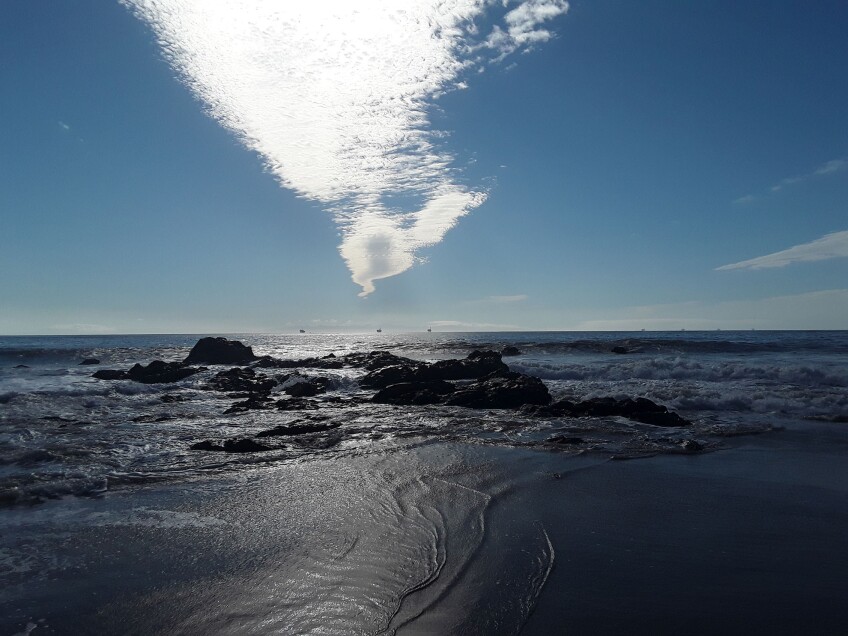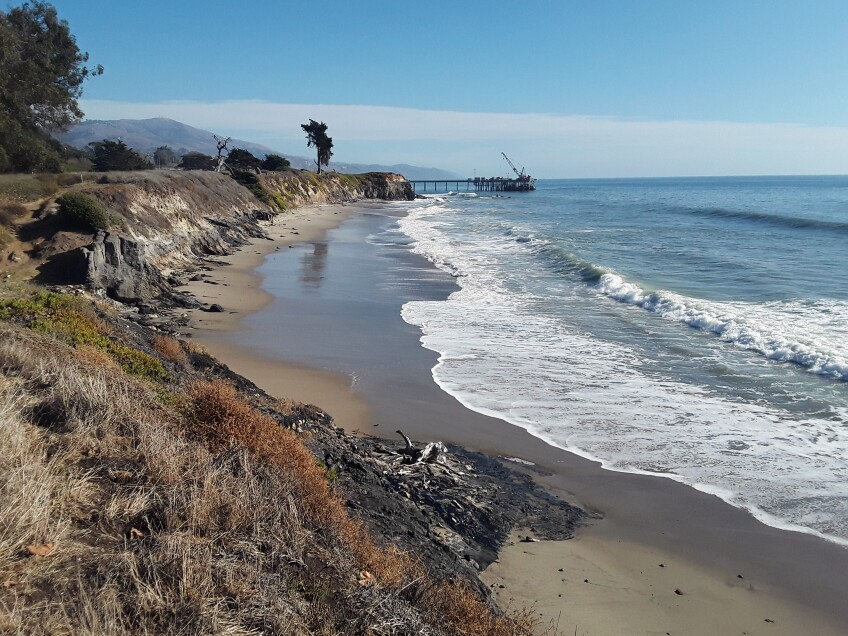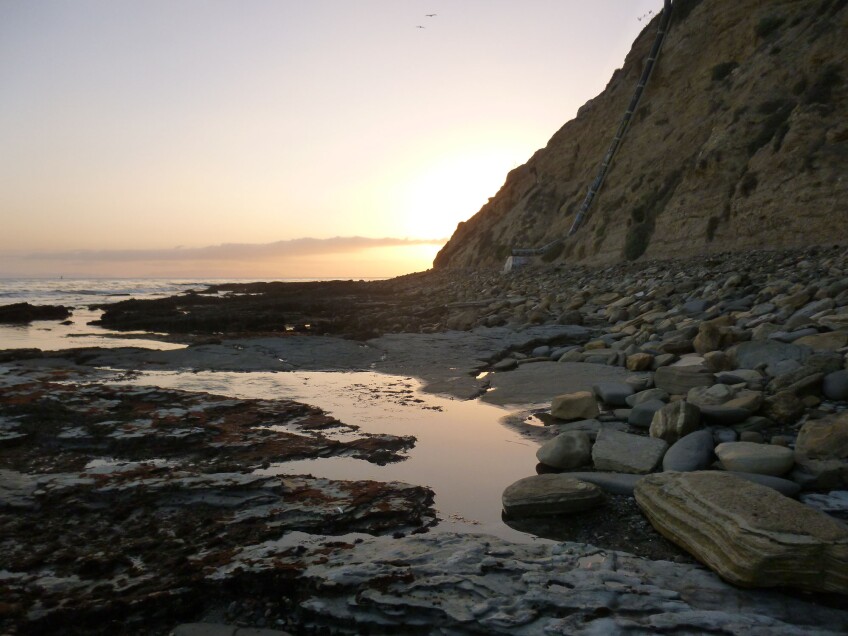
Five Playful SoCal Beach Escapes
You don’t have to be a "beach bum" to enjoy the beautiful bays, craggy coves and sandy stretches of the Southern California coastline. And you don’t even need to know how to swim or surf.
Because there’s much more than meets the eye when it comes to the beaches along the Pacific Coast.
And there are plenty of other ways to explore them.
So whether you’re a bonafide rock-hopper or simply curious about coastal life, here are five excursions to whet your appetite for oceanside recreation — at beaches where you don’t necessarily have to “hang 10” in order to hang out for a while.
1. Victoria Beach/Victoria Cove, Laguna Beach (Orange County)

California hasn't been known for being pillaged by pirates as much as, say, the Caribbean — but the Orange County city of Laguna Beach does have a "pirate tower," tucked away under the cliffs at Victoria Cove on Victoria Beach. Its Medieval-looking door is now locked, but it’s a treat just to view its exterior.
The 60-foot tower is made of poured concrete atop a foundation made of ocean stones and capped by a cone-shaped spire covered in shingles. Its second owner, retired naval officer Harold Kendrick, would dress up in pirate cosplay and tuck coins in between the stones for the neighborhood children to find as "buried treasure" — and for them to keep under the rule of “finders keepers.”
The tower’s construction in 1926 was the work of California Senator William Edward Brown — who’d spend summers with his family in the Norman House above the beach. He wanted to enclose a private staircase leading down to the sand — as well as to his circular, concrete pool just adjacent to his property (the remains of which can still be seen today).
It’s best if your visit coincides with low tide so you can walk the sandy beach to the tower — but even with the tide coming in, you can do some mild scrambling over rocks directly at the bottom of the cliffs to get to your destination. Admire the tidepools along the way.
The biggest challenge, as with many parts of Southern California, is the parking. You can try snaking your way through the narrow, winding streets above Victoria Beach in search of a spot, but you’re more likely to snag one across the PCH. From there, set off on foot to one of several public staircases that lead down to the beach from Victoria Drive. Check for closures, as some public beach access points are slated to be blocked-off until May 2021. Your best bet is the emergency vehicle access ramp at the end of Dumond Drive — and when you hit sand, turn right to walk north towards the tower.
2. Tar Pits Park, Carpinteria State Beach, Carpinteria (Santa Barbara County)




At the southernmost section of Carpinteria State Beach, just south of Santa Barbara, you’ll find a sticky and stinky surprise — asphaltum, a.k.a. tar. Together, several different natural tar deposits form what geologists call an "asphalt lake" — just like the one at La Brea Tar Pits in Los Angeles, only older.
The Carpinteria "Oil Seeps" could date back as far as 2.5 million years ago — to the time of such prehistoric megafauna as mammoths, giant sloths, dire wolves, tusked mastodons and native camels. Historians have determined that Chumash villagers tapped into the seepage to help seal their boats and baskets. And likewise, late-19th century Californios discovered that the tar also did a good job of sealing paved roads — so they mined the beach's resources to lay the first asphalt on Santa Barbara County's dirt roads, starting with nearby Linden Avenue.
Even today, the tar erupts to the surface and bulges out in hulking, black gobs. To see it for yourself, enter at the state beach kiosk, pay the entry fee and turn left for the parking area of the Tar Pits Park. You’ll find yourself tiptoeing among the remains of the former Sattler, Alcatraz and Higgins (1912-1935) asphalt mines — as well as what was once used by locals as a trash pit (until the mid-1950s).
Nobody taps into the tar pits at Carpinteria State Beach anymore — but nobody seems to try to stop the glop, either. It flows hot, hoping to capture an animal or a shoe, until it cools off and hardens with rain or the incoming surf. Hopefully, a couple of million years of evolution have taught the animal kingdom to avoid the inky mess.
Wear shoes you don’t mind getting sticky — and bring something to remove the tar before tracking it into your car. While some industrial solvents will work, all you may need is a bag of ice (to harden the tar and then chip it off), a degreasing detergent or even some olive oil. Even if you avoid the big piles of goo, you might accidentally step on a tiny tarball that’s washed ashore onto the sand.
Bonus: The Coastal Vista Trail leads south from Tar Pits Park to Carpinteria Bluffs Nature Preserve, which offers stunning views and a colony of harbor seals in their nesting area (a.k.a. rookery) in a protected preserve.
3. La Jolla Cove, La Jolla (San Diego County)




For a relatively small beach, La Jolla Cove has tons to offer visitors — whether you’ve got just a few minutes or a whole day to spend. Start out at the circa 1931 sea wall that juts out from Coast Boulevard, where you can get the lay of the land, observe sunbathing sea lions and maybe even find a parking spot.
You’ll see lots of recreational opportunities within the San Diego La Jolla Underwater Park Ecological Reserve — including snorkeling among the leopard sharks and kayaking (either on your own or on a guided tour from La Jolla Sea Cave Kayaks or La Jolla Kayak). Whether in or on the water, you’ll traverse a submerged canyon, a reef and a kelp forest — all of which lurk in the deep waters below.
You’ll be surrounded by seven sister caves — but if you don’t want to get wet, or only have time for a short visit, you can choose La Jolla’s most famous one, Sunny Jim Cave. In 1902, German artist, mining engineer and entrepreneur Gustav Schultz hired Chinese laborers to dig out a tunnel to the cave — and, nearly two years, had created the only entrance to any California sea cave that’s accessible by land (as opposed to by sea). Legend has it that during Prohibition, bootleggers used to drop off booze in by rowboat.
To get to it, you’ll have to pay admission at the Cave Store, the wood-shingled house where Schultz once lived, circa 1906. After climbing down 145 steps (which is better than being lowered down by rope, as its first visitors were), you’ll peer out at the cove from a platform as waves splash up and the rock walls drip. Adaptations for the COVID-19 pandemic include pivoting to self-guided, private tours (single households only) by advance reservation, available from 9 a.m. to 5 p.m. daily.
4. Nicholas Canyon County Beach, Malibu (Los Angeles County)




Located along the 27 miles of scenic beauty that the City of Malibu offers, Nicholas Canyon Beach is a Los Angeles County-run beach that serves as a destination for kite surfers and surfers, the latter of whom refer to it as "Point Zero" or "The Zeroes." They say it's one of the last beaches in L.A. County where you can find the "perfect point break" — a.k.a. a rocky point where the waves break. Perhaps not coincidentally, it’s just one beach down from where the original "Point Break" movie was filmed (at Leo Carrillo State Beach, to the north).
The beach is at the mouth of San Nicholas Canyon Creek — and depending on the time of year, you might spot some trickles of natural water coming down the bluffs in certain spots. The sandy beach itself serves as hauling grounds for sea lions—and just offshore, the waters are full of kelp beds and submerged treasures for scuba divers. And if you visit at low tide, you can dig your toes into the sand amidst rock-clinging mussels, clams and sea anemones in the tidepools.
These 23 acres comprise former privately-owned beachfront property — whose homeowners were allegedly "obstructing" beach access. So, the land was repossessed, 49 homes were demolished, and the Los Angeles County Department of Beaches and Harbors purchased the beach in 1975 for a cool $3 million, partially using funds from the Land and Water Conservation Fund Grant. It was the county's first beach acquisition in 30 years.
For some history that dates back before Hollywood elites like Vincent Price and Margot Kidder resided there, you can explore a recreated Chumash village — the only living Chumash cultural village of its kind in Southern California — courtesy of the Wishtoyo Chumash Foundation.
While the foundation has temporarily suspended all events, field trips, in-person meetings and on-site educational programming because of the COVID-19 pandemic, you can follow them on Facebook for updates on its future reopening.
5. Cabrillo Beach, San Pedro (Los Angeles County)




Managed by the City of Los Angeles Department of Recreation and Parks, and tucked into the Port of Los Angeles West Channel, Cabrillo Beach is actually two beaches in one. The inner beach is within the harbor, protected by the San Pedro Breakwater, which has protected San Pedro Bay since the turn of the last century.
The outer beach features more active surf. Both were named after Portuguese explorer Juan Rodríguez Cabrillo, who navigated the west coast from Mexico to San Diego Bay and all the way up past Santa Monica Bay, the Channel Islands, Monterey Bay and the San Francisco Bay (which he technically missed).
Originally, there was no sand to be found between San Pedro’s cliffs and the Pacific Ocean. So, after the breakwater was constructed (of rocks from Catalina Island and Chatsworth), the outer beach was created in 1927 by adding sand that had been removed from harbor dredging. It officially opened in 1928.
Visit Outer Cabrillo Beach at low tide, and you can follow the Cabrillo Coastal Park trail towards Point Fermin State Marine Park, where marine life collects in the seawater that becomes trapped in the depressions in the rocks after the tide goes out. In those tidepools, you can find hermit crabs and sea anemones and even maybe a starfish or an urchin — but you can't collect them as souvenirs. When it opened in 2000, thanks to grants from the California State Coastal Conservancy, the 300-foot boardwalk became the country’s first wheelchair-accessible trail leading to an ocean beach on the Pacific Coast.
Cabrillo Beach is also where you’ll find Cabrillo Marine Aquarium, which is temporarily closed for COVID-19, and the annual grunion run — a spawning event that runs March through September, reaching its peak on select nights from late March to early June. According to the California Department of Fish and Wildlife, you need a valid California sportfishing license (including the ocean enhancement stamp) to interact with the fish in any way — even if you're not keeping them — unless you’re under age 16. No license is required to simply observe the spawning behavior, but be sure to stay 6 feet away from people outside your household and wear a face-covering whenever that’s not possible.
Bonus: Also on the outer beach is the restored, circa 1932 Cabrillo Beach Bath House — one of the last bathhouses built in Southern California and designated a historic landmark. This 26,000-square-foot, Mediterranean-style structure was used in the 1932 Olympics and is currently available for private rentals (like weddings, etc.)
Note: This article has been updated June 29, 2021 to reflect the latest available information.












